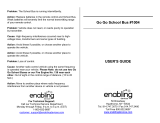
Webasto Thermo & Comfort N.A., Inc. 6 www.techwebasto.com
Safety and General Information
1.5 Regulation for Installation in the
Vehicle
Read this installation guide in its entirety before
installing this equipment.
1.5.1 Position of the Heater
• Parts of the vehicle body and other components
in the immediate vicinity of the heater must be
protected against excessive heat and the danger
of contamination by fuel or oil.
• The internal combustion heater must not pose a
fire hazard even when overheated. This
requirement is deemed to have been met if care
is taken during installation to ensure an
adequate distance from all parts, as well as
adequate ventilation and if fire-resistant
materials or heat shields are used.
• For passenger carrying vehicles such as shuttle
busses, transit busses, and coaches, the heater
must not be installed in the passenger cabin.
• The model/ Serial plate or a duplicate thereof
(duplicate model/ Serial plate) must be fitted in
such a way that it is still clearly legible when the
heater has been installed in the vehicle.
• When positioning the heater, all reasonable
precautions must be taken to minimize the risk
of personal injury or damage to items in the
vehicle.
• A clearly visible indicator within the user's field
of vision must show when the heater is switched
on or off.
1.5.2 Fuel Supply
The coolant heater may only be operated with the
specified fuel (Diesel 1, Diesel 2, Arctic grade, Kerosene
and certain military spec. fuels).
For the routing of fuel lines, the following important
regulations must be adhered to:
• Fuel lines are to be installed in such a way that
they remain unaffected by torsional stresses
created by vehicle and engine movement. They
must be protected against mechanical damage.
• Fuel lines must be securely fastened to the
vehicle every 12 inches (30 cm.) or more often
along the total length from heater to fuel tank.
• Fuel-carrying parts are to be protected against
excessive heat and are to be installed so that any
dripping or evaporating fuel can neither
accumulate nor be ignited by hot components or
electrical equipment.
• In buses, fuel lines are not to be located in the
passenger area or in the driver’s compartment.
Fuel supply must not be by means of gravity or
pressurization of the fuel tank.
• The fuel tank must either be equipped with a
vent cap or be ventilated in another way
(ventilation line).
• The fuel filler neck must not be located in the
passenger compartment and must have a tightly
fitting cap to prevent any fuel leaks.
• The type of fuel and the fuel filler neck must be
clearly identified on heaters for liquid fuel, for
which the fuel supply is separate from the fuel
supply for the vehicle.
• A sign must be affixed to the fuel filler neck
warning that the heater must be switched off
before refuelling. An identical warning must also
be included in the manufacturer's operating
instructions.
1.5.3 Exhaust System
• The exhaust outlet must be positioned in such a
way that exhaust fumes cannot get into the
interior of the vehicle through ventilation
devices, hot-air inlets or open windows.
1.5.4 Combustion Air Inlet
• The air for the combustion chamber of the
heater must not be extracted from the
passenger cabin of the vehicle.
• The air inlet must be positioned in such a way
that it cannot be obstructed by other objects.
1.5.5 Water Inlet
• The supply of water to be heated must be
protected against freezing with a suitable
antifreeze additive to the required strength as
directed by the manufacturer.
• The supply of water to be heated must be
uncontaminated by corrosive compounds and
other impurities.
• The inlet line must be protected from damage.
1.5.6 Hot Water Outlet
• Hot water lines within the vehicle must be
positioned or protected in such a way as to
exclude all risk of injury or damage caused by
direct contact.
• The water outlet line must be protected so that
it cannot be obstructed by other objects or the
flow of water through the lines be blocked.

























